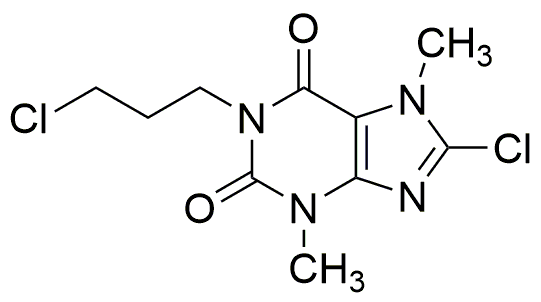8-Chloro-1-(3-chloropropyl)theobromine is widely utilized in research focused on:
- Pharmaceutical Development: This compound is explored for its potential as a therapeutic agent, particularly in the treatment of various diseases due to its unique structural properties that may enhance bioactivity.
- Neuroscience Research: It is studied for its effects on neurotransmitter systems, providing insights into cognitive function and potential applications in neurodegenerative disease therapies.
- Plant Growth Regulation: The compound may serve as a growth regulator in agricultural applications, helping to improve crop yield and resilience against environmental stress.
- Biochemical Assays: Researchers utilize it in assays to study enzyme interactions and metabolic pathways, aiding in the understanding of cellular processes.
- Material Science: It is investigated for its properties in developing new materials, particularly in coatings or composites that require enhanced chemical resistance.
General Information
Properties
Safety and Regulations
Applications
8-Chloro-1-(3-chloropropyl)theobromine is widely utilized in research focused on:
- Pharmaceutical Development: This compound is explored for its potential as a therapeutic agent, particularly in the treatment of various diseases due to its unique structural properties that may enhance bioactivity.
- Neuroscience Research: It is studied for its effects on neurotransmitter systems, providing insights into cognitive function and potential applications in neurodegenerative disease therapies.
- Plant Growth Regulation: The compound may serve as a growth regulator in agricultural applications, helping to improve crop yield and resilience against environmental stress.
- Biochemical Assays: Researchers utilize it in assays to study enzyme interactions and metabolic pathways, aiding in the understanding of cellular processes.
- Material Science: It is investigated for its properties in developing new materials, particularly in coatings or composites that require enhanced chemical resistance.
Documents
Safety Data Sheets (SDS)
The SDS provides comprehensive safety information on handling, storage, and disposal of the product.
Product Specification (PS)
The PS provides a comprehensive breakdown of the product’s properties, including chemical composition, physical state, purity, and storage requirements. It also details acceptable quality ranges and the product's intended applications.
Certificates of Analysis (COA)
Search for Certificates of Analysis (COA) by entering the products Lot Number. Lot and Batch Numbers can be found on a product’s label following the words ‘Lot’ or ‘Batch’.
Numéro de catalogue
Numéro de lot/série
Certificates Of Origin (COO)
This COO confirms the country where the product was manufactured, and also details the materials and components used in it and whether it is derived from natural, synthetic, or other specific sources. This certificate may be required for customs, trade, and regulatory compliance.
Numéro de catalogue
Numéro de lot/série
Safety Data Sheets (SDS)
The SDS provides comprehensive safety information on handling, storage, and disposal of the product.
DownloadProduct Specification (PS)
The PS provides a comprehensive breakdown of the product’s properties, including chemical composition, physical state, purity, and storage requirements. It also details acceptable quality ranges and the product's intended applications.
DownloadCertificates of Analysis (COA)
Search for Certificates of Analysis (COA) by entering the products Lot Number. Lot and Batch Numbers can be found on a product’s label following the words ‘Lot’ or ‘Batch’.
Numéro de catalogue
Numéro de lot/série
Certificates Of Origin (COO)
This COO confirms the country where the product was manufactured, and also details the materials and components used in it and whether it is derived from natural, synthetic, or other specific sources. This certificate may be required for customs, trade, and regulatory compliance.


